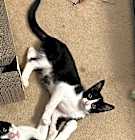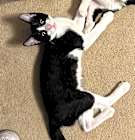Selkirk Rexes come in all eye colors, including green, blue, and amber — a richer, deeper yellow that leans towards a reddish-brown or butterscotch color.
Selkirk Rex
Breed Type: Persian
Common nicknames: Poodle Cat
Coat: Short-haired, long-haired
Hypoallergenic: No, they will likely trigger allergies.
Temperament: Friendly, affectionate, easy-going, mellow
Life expectancy: 10-15 years
Color & patterns:

Selkirk Rex cats were first discovered in Montana in the 1980s, and since then, they’ve been stealing hearts all over the world. This medium-sized breed is known for their unique, curly fur, which often causes them to be described as being “teddy bear-like” in appearance. Unlike other curly-haired cats whose coats have fine, wooly textures, the Selkirk Rex has a plush, dense coat that can be a range of colors and practically begs to be pet. What really makes these cats shine, though, is their friendly and affectionate natures. Selkirk Rex are loyal and love nothing more than snuggling up with their humans and are known for their gentle, easygoing personalities. They make great companions for families or individuals looking for a cat who is as cuddly as they are cute.
Selkirk Rex characteristics
Learn about about Selkirk Rex basics like their fur colors, shedding levels, how much grooming they need, and other Selkirk Rex facts.
Average height
9-11 inches (22.9-27.9cm)
Average weight
6-16 pounds (2.7-7.3 kg)
Average lifespan
10-15 years
Good with other cats
Good with dogs
Affection
Shedding
Health
Exercise needs
How big do Selkirk Rex cats get?
Most Selkirk Rex cats weigh nine to 16 pounds and stand around 9 to 11 inches tall. Male Selkirk Rexes tend to be larger than females. Proper nutrition and exercise can help maintain a healthy weight for your Selkirk Rex.
What color coats can Selkirk Rex cats have?
Selkirk Rexes come in a veritable rainbow of colors, including black, white, red, cream, chocolate, lilac, and blue, and patterns such as bi-color, tri-color, and tabby.
How long do Selkirk Rex cats live?
Selkirk Rex cats typically live between 14 and 20 years. Regular checkups, vaccinations, and preventive healthcare can help identify and address potential health issues early on.
When do Selkirk Rex cats stop growing?
Selkirk Rex cats stop growing and reach their full size around two years old. Like most kittens, Selkirk Rexes experience rapid growth during their kittenhood, typically up to six months old. Growth slows down considerably after the first year, but they continue to fill out for a bit.
Selkirk Rex history
Learn about where this Selkirk Rex came from!
Where are Selkirk Rex cats from?
The Selkirk Rex originates from Montana in the United States. In 1987, a kitten with a plush, curly coat was born to an otherwise normal litter of Persian cats and breeder Jeri Newman decided to develop it into a new breed. This breed is named after Newman’s stepfather, Selkirk, making it the first cat breed named after a person. There are two types: long-haired and short-haired.
Selkirk Rex temperament
Learn about about the Selkirk Rex temperament and how well they fit into your lifestyle, home environment, and family.
Do Selkirk Rex cats meow a lot?
Yes, Selkirk Rexes are known to meow. They don’t shy away from telling you their thoughts, but not every detail: they’re not a vocal nuisance.
Are Selkirk Rex cats friendly?
Yes, Selkirk Rex cats are very friendly. They are quite affectionate with their pet parents and even love playing with children who know how to properly handle them.
Are Selkirk Rex cats good with other cats?
Yes, Selkirk Rex cats have a good chance of getting along with other cats due to their temperament. Selkirk Rexes are incredibly easy-going and, as such, get along well with most other animals.
Are Selkirk Rex cats good with dogs?
Yes, Selkirk Rex cats generally do well with dog companions. Their docility makes them the perfect house companion for a frisky dog. Early socialization with dogs, ideally during kittenhood, helps them feel comfortable around canine companions.
Are Selkirk Rex cats good hunters?
No, Selkirk Rexes are rather decile and not recognized for being the most intense hunters. However, their playful side and natural instincts may still lead them to stalk, swat, and pounce on anything that catches their eye.
Are Selkirk Rex cats good indoor cats?
Yes, Selkirk Rex cats are good indoor cats. The American Veterinary Medical Association recommends that all cats be kept indoors for their own safety.
Are Selkirk Rex cats active?
No, Selkirk Rex cats are not overly active. This is a mellow breed, so while they are somewhat playful, they mostly love to lounge around or on their favorite humans.
Are Selkirk Rex cats good lap-cats?
Yes, Selkirk Rexes are good lap-cats. They love their people, and they love their people’s laps, too. They are not typically shy of visitors and are truly fond of engaging with all humans and other animals.
Selkirk Rex health
Learn about about the Selkirk Rex health outlook and what diseases they may be prone to at various stages of their life.
Do Selkirk Rex cats shed?
Yes, Selkirk Rex cats shed moderately, so while they won’t leave your house fur-free, they also won’t coat your furniture in a constant layer. Shedding might increase slightly during peak shedding seasons, such as summer and winter.
Do you need to groom a Selkirk Rex cat?
Yes, you need to groom Selkirk Rex cats. The Selkirk Rex has a dense, fluffy, soft coat that can feel like lambswool. Prevent mats and tangles in your Selkirk Rex’s coat by brushing or combing them twice weekly. In addition to brushing, all cats should have their claws trimmed every two weeks or so. Cats are also prone to periodontal disease and should have their teeth brushed two to three times a week.
Are Selkirk Rex cats hypoallergenic?
No, Selkirk Rex cats are not hypoallergenic. Cat allergies stem from Fel d 1, a protein found in cat saliva, urine, and dander. All cats produce Fel d 1, regardless of breed. Some people with allergies may find they react less severely to certain cats, but it’s unpredictable and not a guarantee. If you’re set on a Selkirk Rex but have allergies, consider spending time with one before bringing it home to gauge your reaction.
Are Selkirk Rex cats healthy?
Yes, Selkirk Rexes are mostly healthy but can have some issues that plague them, including:
Hypertrophic cardiomyopathy (HCM): HCM is an abnormal thickening of the left ventricle of the heart that leads to improper blood flow. It is the most common cause of heart disease in cats and can result in sudden death.
Hip dysplasia: Selkirk Rex can suffer from hip dysplasia. This condition occurs when the hip joint grows abnormally or is misshapen. The abnormal shape prevents the joints and sockets from adequately meeting one another, resulting in rubbing and grinding instead of sliding smoothly. Over time, the rubbing from dysplasia can cause a variety of issues, such as pain, lameness, and secondary osteoarthritis. Surgery can be done to fix the joint if diagnosed before the onset of arthritis.
Polycystic kidney disease (PKD): PKD is an inherited condition that causes cysts in the kidneys, leads to enlarged kidneys, and may result in renal failure. There is a genetic test available to pinpoint this disease.
Find Selkirk Rex kittens near you
Adopting a Selkirk Rex
We don't see any Selkirks available for adoption in your exact location or cities near you, but here are some adorable similar breeds in Beverly Hills, CA.

Ronny
Devon Rex Domestic Shorthair
Male, 5 mos
Long Beach, CA
Not good with dogs
Not good with cats

Harry
Devon Rex Domestic Shorthair
Male, 5 mos
Long Beach, CA
Not good with dogs
Not good with cats

Ronny
Devon Rex Domestic Shorthair
Male, 5 mos
Long Beach, CA
Not good with dogs
Not good with cats

Harry
Devon Rex Domestic Shorthair
Male, 5 mos
Long Beach, CA
Not good with dogs
Not good with cats
